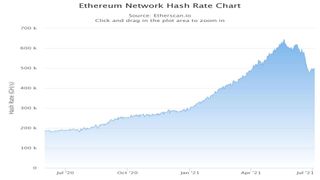The GPU power going into the ethereum network has dropped by 19% in just one month
And bitcoin has taken the unprecedented step of knocking down the difficulty of solving a block.

The ethereum cryptocurrency's total network hash rate has dropped by 19% in just a single month. That's the total power going into generating blocks, and represents the amount of hardware being pointed at the GPU-centric algorithm. This hefty drop in the network hash rate just highlights the huge impact that China's recent crypto crackdown has had on the industry.
You can see in the graph below (via Etherscan) that the hash rate has started to level out after the recent, significant drops. That would seem to suggest this is purely based on the systemic shutdown of graphics card mines in China.
The Chinese government has looked to stamp out cryptocurrency mining in many regions, such as Sichuan, Yunnan, and Inner Mongolia—those where energy costs were lowest—because of the sheer level of resources those operations were consuming. At the same time financial institutions in the country have been carrying out their own, maybe government mandated, purge on cryptocurrency services and trading.

All of this means that GPU mining in China, where the bulk of the world's graphics card mines are to be found, is becoming far less attractive an enterprise. That has led to reports of a growing tide of second-hand graphics cards starting to appear for prices sometimes close to MSRP.
From the high of 643.81 TH/s back in May, we are now seeing a levelling off of the total network hash rate to 499.55 TH/s. It must be said that is only a downswing to the level we were at back in April, which was still higher than it had ever been before, but still shows the impact of recent events.
There is a chance this is merely a lull in proceedings, an ethereum hiatus, before miners set up shop somewhere else in the world and go HAM at the hash rate and spike it ever further. Equally this could be the beginning of the end for ethereum-based GPU mining, with profitability waning and the looming fork to a proof-of-stake rather than proof-of-work, graphics card based process.
GPU prices have been dropping in China because of this, and we've also seen signs that the cost of graphics cards is starting the long, winding road back to normalcy in Germany and Russia too.
The biggest gaming news, reviews and hardware deals
Keep up to date with the most important stories and the best deals, as picked by the PC Gamer team.
Ethereum isn't the most widely known of the cryptocurrencies, though it is the one most inextricably linked to PC gaming because of its hardware requirements. Bitcoin is still the biggie and that crypto is actually taking the unprecedented step of making mining easier, and therefore more profitable.


Best CPU for gaming: the top chips from Intel and AMD
Best graphics card: your perfect pixel-pusher awaits
Best SSD for gaming: get into the game ahead of the rest
According to reports, the bitcoin network recalibrates its difficulty level approximately every two weeks, and because of the mining crackdown in China the amount of time it takes to solve a bitcoin block has been hitting the 19 minute mark. That's up from a typical 10 minute completion time, which is seen as more desirable.
The bitcoin code has now made it some 28% easier to mine a block, which theoretically will return the block time to the 10 minute mark.
That won't have any impact on GPU prices as it's dedicated ASICs not graphics cards that are being sent down the bitcoin mines, but is still a fascinating look into what's currently happening in the cryptocurrency market as a whole.

Dave has been gaming since the days of Zaxxon and Lady Bug on the Colecovision, and code books for the Commodore Vic 20 (Death Race 2000!). He built his first gaming PC at the tender age of 16, and finally finished bug-fixing the Cyrix-based system around a year later. When he dropped it out of the window. He first started writing for Official PlayStation Magazine and Xbox World many decades ago, then moved onto PC Format full-time, then PC Gamer, TechRadar, and T3 among others. Now he's back, writing about the nightmarish graphics card market, CPUs with more cores than sense, gaming laptops hotter than the sun, and SSDs more capacious than a Cybertruck.
Most Popular






